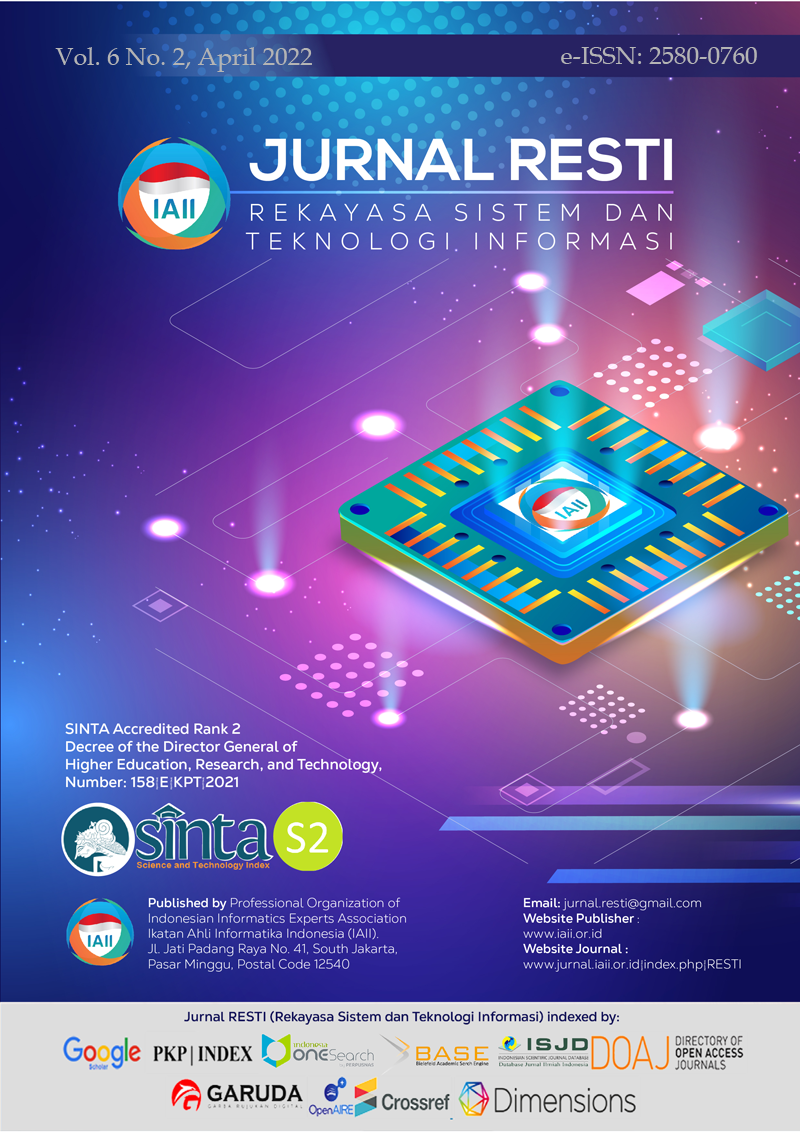The Clustering Rice Plant Diseases Using Fuzzy C-Means and Genetic Algorithm
Abstract
Rice is an agricultural sector that is very important for Indonesia's economy. The main problem with rice plants is pest and disease control which has a hazardous impact and economic losses for farmers. The apparent characteristics of rice leaves have a greater area than other plant structures; rice leaves can be applied for the early diagnosis of rice plant diseases. The approaches employed are fuzzy C-Means (FCM) and Genetic Algorithm-Fuzzy C-Means (GA-FCM). The center of the cluster is obtained while adopting genetic algorithms for optimization. The primary dataset used in this research is Teaching Sawah Farm IPB, and the second dataset is UCI Rice Leaf Diseases. According to the comparison results, the GA-FCM optimization results in a higher level of clustering precision with a 65% optimal cluster center point on the silhouette coefficient value compared to just 60% for FCM. This research shows that the proposed method can add 5% accuracy to the clustering results in correctly identifying rice plant diseases.
Downloads
References
Reflis, M. Nurung, and J. Pratiwi, “Motivasi Petani Dalam Mempertahankan Sistem Tradisional Pada Usahatani Padi Sawah Di Desa Parbaju Julu Kabupaten Tapanuli Utara Propinsi Sumatera Utara”, J. AGRISEP, vol. 10, no. 1, pp. 51 – 62, 2011.
Badan Pusat Statistik, “Luas panen dan produksi padi pada tahun 2019 mengalami penurunan dibandingkan tahun 2018 masing-masing sebesar 6,15 dan 7,76 persen”, Bps.go.id, 2020 [Online]. Avaible:https://www.bps.go.id/pressrelease/2020/02/04/1752/luas-panen-dan-produksi-padi-pada-tahun-2019-mengalami-penurunan-dibandingkan-tahun-2018-masing-masing-sebesar-6-15-dan-7-76-persen.html.
Balai Besar Penelitian Tanaman Padi, Penyakit Blas pada Tanaman Padi dan Cara Pengendaliannya, Subang: Kementerian Pertanian, 2015.
P. Djojosumarto, Teknik Aplikasi Pestisida Pertanian. Yogyakarta: Kanisius, 2000.
Departemen Pertanian, Gerakan Pengendalian Organisme Pengganggu Tumbuhan (OPT) Serealia. Jakarta: Direktorat Jenderal Tanaman Pangan Kementerian Pertanian, 2018.
H. Semangun, Penyakit-Penyakit Tanaman Pangan Di Indonesia, Yogyakarta: Gadjah Mada University Press, 2008.
S. Zahrah, R. Saptono, and E. Suryani, “Identifikasi Gejala Penyakit Padi Menggunakan Operasi Morfologi Citra”, J. Seminar Nasional Ilmu Komputer, pp. 100–106, 2016.
C. Dewi, E. Anjarwati, and C. Imam, “Implementasi citra digital untuk identifikasi penyakit pada daun padi menggunakan ANFIS”, J. Seminar Nasional Penelitian & Pengabdian pada Masyarakat, vol. 1, no. 1, pp 114-117, 2018, doi: https://doi.org/10.33019/snppm.v1i0.511.
A. Fitriansyah, “Pengolahan Citra Digital Penyakit Tanaman Padi Menggunakan Metode Maksimum Entropy”, J. Semirata FMIPA, pp. 21–23, 2013.
Zhou, Yingfeng, W. Yaming, and Y. Qing, “Segmentation of Rice Disease Spot Based on Improved BPNN”, IEEE International Conference on Image Analysis and Signal Processing, pp. 575-578, 2010, doi: 10.1109/IASP.2010.5476050.
N. N. Kurniawati, S. N. H. S. Abdullah, S. Abdullah and S. Abdullah, "Texture analysis for diagnosing paddy disease", IEEE International Conference on Electrical Engineering and Informatics, pp. 23-27, 2009, doi: 10.1109/ICEEI.2009.5254824.
S. Dhaygude, and N. Kumbhar, “Agricultural Plant Leaf Disease Detection Using Image Processing”, International Journal of Advanced Research in Electrical, Electronics and Instrumentation Engineering, vol. 2, no. 1, pp. 599–602, 2013.
E. D. Nurcahya, “Ekstraksi Fitur Pertumbuhan Padi Berdasar Warna Daun Menggunakan Analisa Ruang Warna Hue Saturation Value”, J. Multitek Indonesia: Jurnal Ilmiah , vol. 13, no. 1, pp. 24–33, 2019, doi: http://dx.doi.org/10.24269/mtkind.v13i1.1515.
N. Widyastuti, and H Amir, "Penggunaan Algoritma Genetika dalam Peningkatan Kinerja Fuzzy Clustering untuk Pengenalan Pola", J. Berkala Ilmiah MIPA, vol. 17, no. 2, pp. 1-14, 2007.
V. G. Biju and P. A. Mythili, “Genetic Algorithm based Fuzzy C Mean Clustering Model for Segmenting Microarray Images”, International Journal of Computer Applications, vol. 52, no. 11, pp. 42–48, 2012.
P. Darma, Pengolahan Citra Digital, Yogyakarta: Andi, 2010.
R. M. Haralick, K. Shanmugam and I. Dinstein, "Textural Features for Image Classification", IEEE Transactions on Systems, Man, and Cybernetics, vol. 3, no. 6, pp. 610-621, 1973, doi: 10.1109/TSMC.1973.4309314.
M. H. Purnomo and A. Muntasa, Konsep Pengolahan Citra Digital dan Ekstraksi Fitur, Yogyakarta: Graha Ilmu, 2010.
E. Prasetyo, “Reduksi Dimensi Set Data dengan DRC pada Metode Klasifikasi SVM dengan Upaya Penambahan Komponen Ketiga”, SNATIF, pp. 293-300, 2014.
H. Bandemer and S. Gottwald, Fuzzy Sets, Fuzzy Logic, Fuzzy Methods with Applications, England: Wiley, 1996.
M. Gen and R. Cheng, Genetic Algorithms and Engineering Optimization. New York: John Wiley & Sons, 2000.
H. A. Saputro, W. F. Mahmudy and C. Dewi, “Implementasi algoritma genetika untuk optimasi penggunaan lahan pertanian”, J. Mahasiswa PTIIK Universitas Brawijaya, vol. 5, no. 12, 2015.
P. E. Mas`udia and R. Wardoyo, “Optimasi Cluster Pada Fuzzy C-Means Menggunakan Algoritma Genetika Untuk Menentukan Nilai Akhir”, J. IJCCS, vol. 6, no. 1, pp. 101-110, 2012, doi: http://dx.doi.org/10.22146/ijccs.2145.
R. R. d. de Vargas and B. R. C. Bedregal, "A Way to Obtain the Quality of a Partition by Adjusted Rand Index", Workshop-School on Theoretical Computer Science, pp. 67-71, 2013, doi: 10.1109/WEIT.2013.33.
F. Klawonn and F. Höppner, “What Is Fuzzy about Fuzzy Clustering? Understanding and Improving the Concept of the Fuzzifier”, Advances in Intelligent Data Analysis, vol. 2810, pp. 254-264, 2003, doi: https://doi.org/10.1007/978-3-540-45231-7_24.
Copyright (c) 2022 Jurnal RESTI (Rekayasa Sistem dan Teknologi Informasi)

This work is licensed under a Creative Commons Attribution 4.0 International License.
Copyright in each article belongs to the author
- The author acknowledges that the RESTI Journal (System Engineering and Information Technology) is the first publisher to publish with a license Creative Commons Attribution 4.0 International License.
- Authors can enter writing separately, arrange the non-exclusive distribution of manuscripts that have been published in this journal into other versions (eg sent to the author's institutional repository, publication in a book, etc.), by acknowledging that the manuscript has been published for the first time in the RESTI (Rekayasa Sistem dan Teknologi Informasi) journal ;








